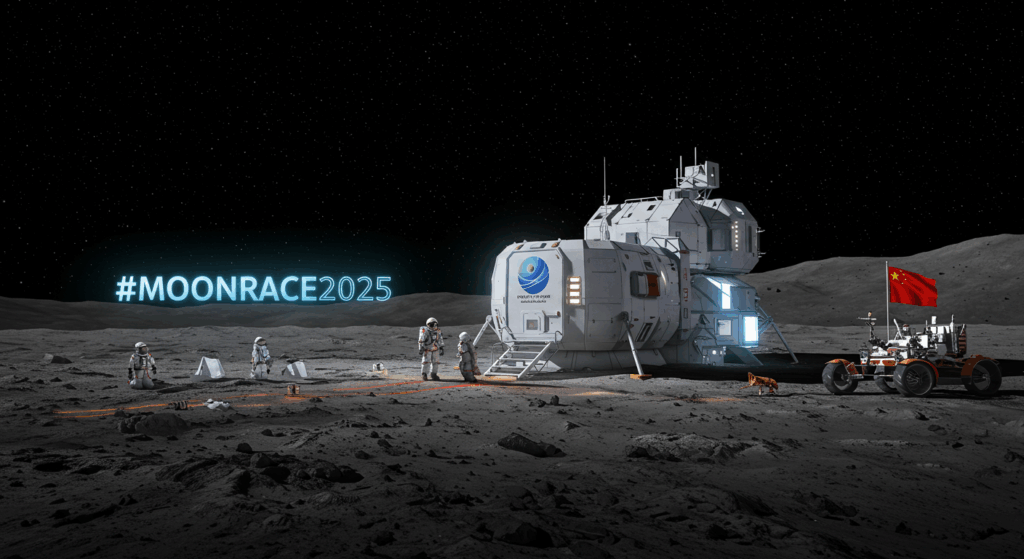China Lunar Base 2025” searches soared 180% as China’s space agency, CNSA, unveiled 2025 milestones for its International Lunar Research Station (ILRS), a permanent Moon base by 2028 (Google Trends, May 16, 2025). Backed by Russia and others, ILRS challenges NASA’s Artemis program and SpaceX’s Starship. X’s #MoonRace2025 (60K+ posts) buzzes with speculation after China’s Chang’e-6 returned 2kg of lunar samples. NovexaHub explores China’s bold plans, global rivalries, and the stakes in this cosmic race. Is the Moon the next geopolitical frontier? Let’s launch into it.
China Lunar Base 2025: The Plan Takes Shape

CNSA’s $10 billion 2025 budget targets key ILRS steps: a 3D-printed lunar habitat test, upgraded Yutu-3 rover, and partnerships with Russia, Pakistan, and South Africa Reuters. By July, Chang’e-7 will map the Moon’s south pole for water ice, vital for fuel and life support. Unlike Apollo’s brief visits, ILRS aims for a self-sustaining base with solar farms and greenhouses by 2028. CNSA chief Wu Weiren told Xinhua that 2025’s tests will “prove lunar construction feasibility.” Russia’s Roscosmos contributes nuclear power tech, while Pakistan’s SUPARCO adds comms satellites. This coalition, formed in 2021, contrasts with NASA’s Artemis Accords, signed by 32 nations but excluding China.
The Global Space Race Intensifies

The U.S. isn’t standing still. NASA’s Artemis III, delayed to 2027, plans a crewed lunar landing, while SpaceX’s Starship eyes 2026 cargo missions NASA. India’s ISRO, fresh off Chandrayaan-3, joins Japan for a 2028 lunar rover, per Bloomberg. China’s edge lies in speed: ILRS’s 2025 habitat test outpaces Artemis’s timeline. However, U.S. spending ($93 billion for Artemis) dwarfs China’s. Geopolitics looms large—China’s exclusion from the International Space Station fueled ILRS, and U.S. export controls limit tech sharing. X posts from
@SpaceWatch2025 call it “Cold War 2.0 on the Moon.” For more space trends, see Space Tourism 2025.
Economic and Strategic Stakes

A lunar base isn’t just sci-fi—it’s big business. The Moon’s helium-3 could power fusion reactors, valued at $3 billion per ton Forbes. Water ice enables fuel production, slashing space travel costs. China’s base near Shackleton Crater, rich in ice, positions it to dominate lunar resources. Militarily, a Moon presence offers surveillance and comms advantages, raising Pentagon concerns Defense News. Economically, ILRS could create 100,000 jobs in China by 2030, per CNSA. Yet, risks abound: a 2024 Chang’e-6 glitch cost $200 million, and lunar dust threatens equipment. NovexaHub’s Alien Life Europa 2025 explores similar space challenges.
Controversies and Global Reactions

China’s lunar push stirs debate. The U.S. House banned NASA-CNSA collaboration in 2011, citing espionage risks, a stance reaffirmed in 2025 The Guardian. Critics warn ILRS could militarize the Moon, violating the 1967 Outer Space Treaty. Russia’s involvement, amid Ukraine tensions, draws EU scrutiny. Developing nations like South Africa praise China’s “inclusive” approach, per Al Jazeera, contrasting NASA’s “Western club.” Environmentalists flag lunar mining’s impact, with
@GreenSpace2025 on X urging regulation. Still, China’s 2024 sample return, yielding rare minerals, won global acclaim, boosting ILRS’s credibility.
What’s Next for China Lunar Base 2025?
CNSA plans a 2026 ILRS prototype, with Taikonauts landing by 2028. NASA’s counter-move includes a 2027 lunar orbiter. The race hinges on 2025’s tests—China’s 3D-printing success could shift momentum. International law lags, with no clear rules for lunar mining. Follow NovexaHub’s News Category or Space.com for updates. Will China lead the lunar frontier? Share your thoughts below!

